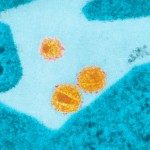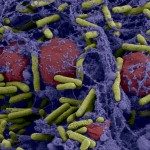Link to Pubmed [PMID] – 21118814
J. Biol. Chem. 2011 Feb;286(7):4978-90
CC chemokine receptor 5 (CCR5) is a G-protein-coupled receptor for the chemokines CCL3, -4, and -5 and a coreceptor for entry of R5-tropic strains of human immunodeficiency virus type 1 (HIV-1) into CD4(+) T-cells. We investigated the mechanisms whereby nonpeptidic, low molecular weight CCR5 ligands block HIV-1 entry and infection. Displacement binding assays and dissociation kinetics demonstrated that two of these molecules, i.e. TAK779 and maraviroc (MVC), inhibit CCL3 and the HIV-1 envelope glycoprotein gp120 binding to CCR5 by a noncompetitive and allosteric mechanism, supporting the view that they bind to regions of CCR5 distinct from the gp120- and CCL3-binding sites. We observed that TAK779 and MVC are full and weak inverse agonists for CCR5, respectively, indicating that they stabilize distinct CCR5 conformations with impaired abilities to activate G-proteins. Dissociation of [(125)I]CCL3 from CCR5 was accelerated by TAK779, to a lesser extent by MVC, and by GTP analogs, suggesting that inverse agonism contributes to allosteric inhibition of the chemokine binding to CCR5. TAK779 and MVC also promote dissociation of [(35)S]gp120 from CCR5 with an efficiency that correlates with their ability to act as inverse agonists. Displacement experiments revealed that affinities of MVC and TAK779 for the [(35)S]gp120-binding receptors are in the same range (IC(50) ∼6.4 versus 22 nm), although we found that MVC is 100-fold more potent than TAK779 for inhibiting HIV infection. This suggests that allosteric CCR5 inhibitors not only act by blocking gp120 binding but also alter distinct steps of CCR5 usage in the course of HIV infection.




